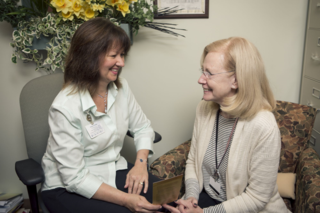The number of adults and childhood cancer survivors in the United States is expected to reach 19 million in 10 years, nearly quadruple what it is today, the American Cancer Society reports.
The increase in cancer survivorship is attributable to many factors – from advanced imaging techniques and earlier detection to gene and targeted therapies. Now, with folks living longer, more attention is being paid toward helping them to living better.
One special ingredient that is contributing to the improvement of quality of life is the addition of supportive care services to cancer programs throughout the United States. Sixty percent of all U.S. comprehensive cancer centers have supportive care programs and about 50 percent of those centers plan to expand their programs. Understandably so – more than a few studies show that these services really help.

Marylou Osterman, patient services coordinator at the Abramson Cancer Center at Pennsylvania Hospital and cancer survivor and Cancer Center volunteer, Ginny Fineberg.
For example, acupuncture is a popular support service offered in many programs. One recent Penn Medicine study published online in the Journal of Clinical Oncology showed that acupuncture effectively reduces hot flashes in breast cancer patients with little or no side effects.
In 2013, a paper published in JAMA Internal Medicine involving a meta-analysis of 27 research trials conducted over 23 years, revealed that cancer patients who engaged in creative arts therapy experienced less depression and anxiety than those who did not. The participants also reported less pain, anxiety and depression compared to those who did not do the arts activities..
Over the past 18 years the Joan Karnell Supportive Care Program (JKSCP) of the Abramson Cancer Center at Pennsylvania Hospital (ACC PAH) has built up its services along with a solid reputation for offering a robust gamut of informational, educational, and strategic ways to help patients and families cope with a cancer diagnosis, treatment and beyond.
Operating under the premise that supportive care is the essence of compassionate care, the JKSCS program offers an impressive total of 29 different services and programs – including nutritional counseling, mindfulness-based stress reduction courses, and art therapy – available for individual use or to be used in combinations to best address a patient’s needs. The person behind the supportive-care-curtain coordinating them all is Marylou Osterman, the ACC PAH Patient Services coordinator.
With a degree in special education, Osterman taught in the classroom for four years before finding her true calling in health care. She joined the ACC at PAH in 2001, when the supportive care program was just beginning to flourish under the leadership of the Arthur Staddon, MD, director of the ACC PAH, director of the Bone or Soft Tissue Sarcoma Program and a clinical professor of Medicine at Penn’s Perelman School of Medicine, and Mary Pat Lynch, CRNP, MSN, AOCNP, administrator of what?.
“Supportive care services are integral to excellent cancer care,” Staddon said. “They allow our patients to process their cancer diagnosis, manage side effects of disease and its treatment, navigate the complex world of cancer care, and engage in goals of care decisions with their health care team.”
Osterman’s primary role is to serve as the point of contact for patients, staff and community organizations and coordinates cancer program activities, including Survivors Day, cancer awareness and screening events, patient education conferences, health fairs and other community outreach programs. In addition, she promotes the supportive services to patients, physicians and staff and also works behind the scenes to develop ideas for future initiatives and provides support to the Center’s team.
“Each day I listen to patient stories, and direct people toward services and resources to help them face the challenges of having cancer because we’ve always believed that the less anxiety and distress our patients feel, the more energy they can channel toward their recovery and overall quality of life,” Osterman said. “We understand how overwhelming a cancer diagnosis and treatment can be and through our support program, we hope to help patients and their family members better cope with the physical, emotional and financial stress of their situation."
Indeed, managing costs is one, often difficult, aspect of managing cancer. A cancer diagnosis is often financially devastating. The burden it places on patients and their loved ones inspires ACC PAH staff to be resourceful and creative to find ways to provide and fund appealing and effective supportive care services, all at no cost to patients.
Patients have access to a wide-range of services aimed at symptom relief, such as shiatsu massage therapy, acupuncture, psychological counseling, pain management/palliate care services and more – and are invited to attend participate in special events such as National Cancer Survivor’s Day (celebrated all month long every June at the ACC PAH), and the annual “Souper Bowl.”
From dealing with their diagnosis, to financial worries and pain management, Osterman is constantly amazed by the resilience of the people she interacts with at the ACC PAH. “I think people might think that it’s depressing to work at a cancer center but I find it to be a supportive and hopeful place,” she says.
Another aspect of her job that Osterman enjoys is supporting the initiatives of others which she says gives her the opportunity to meet new people and see things from a different perspective.
“Being able to put yourself in someone else’s shoes is necessary for empathy - something so vital,” she says, “to interacting with patients and treating them with respect and dignity.”